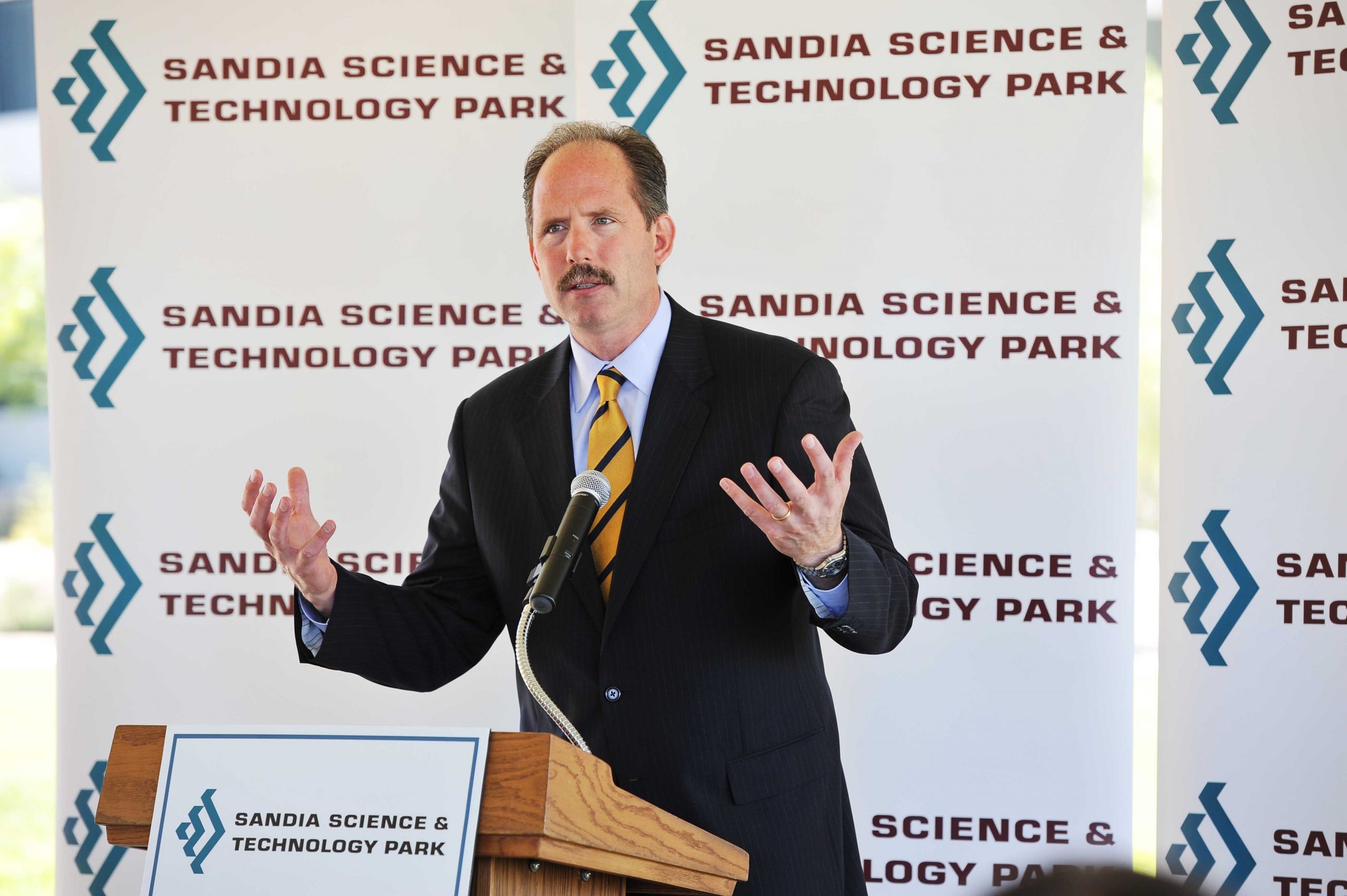ALBUQUERQUE, N.M. — Sandia Science & Technology Park (SS&TP) businesses and Sandia National Laboratories sites in the research park spent $1.2 billion on goods and services and $2.3 billion in wages for more than a decade, giving the local economy a major boost, according to a new report by the Mid-Region Council of Governments (MRCOG).
Albuquerque Mayor Richard Berry announced the report’s findings Tuesday, Aug. 3, at Ted Hobbs Park in the 250-acre master-planned research park. The report is available at http://www.mrcog-nm.gov/economic-development-mainmenu-65.
“The Sandia Science & Technology Park is an excellent example of regional cooperation and coordination that is pushing economic development forward,” Berry said. “It is a model that has been recognized nationally for an innovative approach to regional economic development. The city of Albuquerque is proud to have been an active partner in this important job-creation project since its inception.”
MRCOG assessed the research park’s economic impact on the local and state economy from its inception in May 1998 through the end of 2009. The report also measured the number of Albuquerque-area jobs created in the park, population growth, spending in the community and wage and salary levels.
“Institutions such as the Sandia Science & Technology Park are instrumental in creating economic stability within the region,” said Dewey Cave, MRCOG’s interim executive director. “Even in the face of a tough economy, the park continues to contribute to our nation through innovation and technology, and to our region through increased local investment, area revitalization and spin-off jobs that provide opportunities to our residents.”
The SS&TP’s $1.2 billion cumulative impact, which is reported in 2009 dollars, led to tax revenue increases in the MRCOG region, which includes Bernalillo, Sandoval, Torrance and Valencia counties, the report stated.
Economic activity generated by the research park resulted in gross receipts tax revenue to the state of New Mexico of nearly $58 million. The cumulative gross receipts tax revenue to the city of Albuquerque was $8.2 million, the report showed. Both figures are in 2009 dollars.
“Since its inception in 1998, the Sandia Science & Technology Park was founded as a partnership to promote business growth and facilitate collaboration with Sandia National Laboratories. The park has provided a remarkable boost to the economic community of New Mexico. This public-private partnership is a true testament to the importance of technology commercialization and its important role in job creation,” said Sherman McCorkle, president and CEO of Technology Ventures Corporation and chairman of the board of the SS&TP Development Corporation.
The average salary for full-time employees in SS&TP was $71,612 in 2008, much higher than the average salary for a full-time employee in the area, the report found. Private companies in the park paid an average salary of about $69,000.
“Since park jobs are primarily high technology, mainly engineering and research and development jobs, a high wage rate is associated with them,” the report stated.
The SS&TP has been home to 2,284 jobs, including about 1,000 Sandia Labs jobs, since its inception. The park’s activities also have created 5,441 indirect jobs, for a total of 7,725 jobs created.
Sandia Labs facilities located in the park include the Center for Integrated Nanotechnologies, the International Programs Building, the Computer Science Research Institute and the Innovation Parkway Office Center.
The SS&TP employed 1,942 people at the end of 2009, a drop of 169 jobs from the previous year due to the recession and to the transfer of 116 jobs out of the park to Sandia’s facilities on Kirtland Air Force Base, the report said.
“The park has experienced a relatively small drop in employment in comparison to the level experienced throughout the city,” the report stated.
Public investment in the park has been nearly $70 million, which includes the U.S. Department of Energy’s (DOE) contribution for construction and equipment, Sandia National Laboratories’ management, land from Albuquerque Public Schools and the New Mexico State Land Office and landfill cleanup by Bernalillo County, the report said. Other federal, state and local governments also helped the park by providing grants or matching funds, the report said. For example, the U.S. Economic Development Administration provided $3.4 million overall in grants for telecommunications infrastructure throughout the park. And, the city of Albuquerque also contributed to infrastructure improvements in the park.
As of March 2010, investment in the park has been more than $331 million with 79 percent coming from private sources, said Jackie Kerby Moore, the park’s executive director.
“Twelve years ago, this area was nothing but dirt and tumbleweeds, but since then the jobs and investments have led people to invest in the surrounding area,” she said. “The park has been a catalyst for economic revitalization in southeast Albuquerque.”
The SS&TP is located next to Sandia, giving the park’s tenant firms access to the Labs’ scientists and engineers. Many tenants either supply Sandia with goods and services or technological products or have licensed and commercialized technologies that originated at the federal laboratory.
The park was named Outstanding Research Park of the Year in 2008 by the Association of University Research Parks.
The park is a partnership of Sandia, the DOE’s National Nuclear Security Administration, Lockheed Martin Corp., Technology Ventures Corporation, the city of Albuquerque, Albuquerque Public Schools, Bernalillo County, the Mid-Region Council of Governments, BUILD New Mexico/Union Development Corporation, the New Mexico State Land Office, the state of New Mexico, the Public Service Company of New Mexico and the Economic Development Administration.

